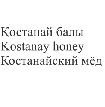|
Indication of the place of production of the goods (boundaries of the geographical object):
Kostanay region
The connection between the characteristics of the product and its place of origin (production):
Natural honey of Kostanay region – this product is unique in that its organoleptic qualities are distinguished by their rich aroma and taste. Kostanay region is famous for its agricultural potential. The best soils of the region are considered to be black soils, they have high fertility, favorable agrochemical and chemical properties, contain 6-4% of humus, have pH 7,2-7,5, absorption capacity 35-40 mg-eq. per 100g of soil. The average score is 48-50. Kostanay region is distinguished by the uniqueness of natural conditions, determined by its inland position. The flora of Kostanay region is represented by 1223 species from 454 genera and 107 families. In the composition of herbaceous forest-steppe vegetation there are endemic species of plants such as: thistle, astragalus kostanai, flax short-fruited, kazakhstani thyme, globe-thistle, phacelia, clover, coriander, thistle, forest sage, dandelion, yellow acacia and many others. Meadow hayfields are concentrated in the floodplains of rivers and estuaries, shrubby thickets are common along the river banks. Agricultural crops are extensively represented in the honey-bearing base of such crops as common melilot, yellow annual melilot, biennial melilot, sainfoin, safflower, rape, common sunflower, buckwheat, etc. Honey harvested from such a variety of honey-bearing plants has a unique flavor and a rich composition of vitamins.
Description of the method of production of the product, as well as information about the conditions of its storage and transportation:
During May, the received bee packages (young bee colonies) are transplanted into hives and engaged in their development, fed with last year's honey, treated for disease, etc. In the first days of June, a nomadic apiary is formed and bee colonies are exported to the sowing fields of honey crops and wild honey plants of the Kostanay region to collect honey (the duration of the season is 3-4 months in the territory of the Kostanay region). From June to September, bees are engaged in honey harvesting, filling the frames with honey in the process. Beekeepers select sealed (mature) frames and place them in a honey pot for pumping honey, after opening them with forks and apiary knives. The pumped honey is placed in a food transport container GOST 5037. All containers are marked and weighed. After the end of the season and the harvesting process, honey is transported in transport containers to the workshop and to the storage warehouse, which must meet veterinary requirements for the storage of animal products. The warehouse is sampled for organoleptic and physicochemical analysis of honey according to GOST19792-2017. Further honey analyzed is allowed for packing and packaging in consumer containers (glass jars GOST 5717 and food plastic). The consumer packaging is marked according to paragraph 4.2. GOST 19792-2001.
Physico-chemical indicators:
Organoleptic
Appearance GOST 19792-2017
Liquid partially crystallized
Fragrance GOST 19792 – 2017
Faint, pleasant, no extraneous smell
Taste GOST 19792 — 2017
Sweet, pleasant, no extraneous flavor
Physico-chemical
The mass fraction of water is 15%
The mass fraction of reducing sugars is 72.2%
The mass fraction of sucrose of sugars is 3.5 %
The diastase number of sugars is 9.8 %
The qualitative reaction to oxymethylfurfor is negative
Signs of fermentation — not detected
Free acidity — 17.0
|

